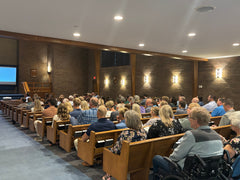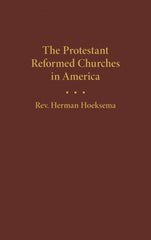Your cart is empty now.

Synods and General Assemblies: The Reformed Church in America (part 2)
The Women-in-Office Agenda Takes Another Step in the RCA
The Reformed Church in America (RCA) Synod 2013’s decision to advance the women-in-office agenda is part of a long process by which proponents of women in office are working towards their goal. The goal of those who want women to be ordained as ministers, elders, and deacons is to force women’s ordination on every congregation and member in the denomination. It takes a long time to achieve that goal. The RCA has been working on it for over 30 years.
The first step towards the goal was probably barely noticed. Maybe no one dared to make bold and declare that women should be installed into church office. A few seminary professors perhaps asked “innocent” and “harmless” questions about the interpretation of relevant Bible passages. “Is it possible that the biblical command that women be silent in the church is time bound or culturally conditioned so that it is not relevant to today?” In the name of academic freedom these professors were allowed to ask their questions and sow the seeds for women’s ordination that would inevitably sprout later.
The second step towards the goal was likely a period of years when individuals openly advocated for women’s ordination. They brought overtures to classis and synod. But they were in the minority so they couldn’t gain the approval of these assemblies. But these individuals were not disciplined. No, they were allowed to stay and teach. After all everyone was trying to interpret Scripture. And for the sake of unity the church should be broad enough to include those for and against women’s ordination. So year after year the assemblies received and rejected overtures to approve women’s ordination.
Then the third step came. A very momentous step! Eventually these bold proponents of women’s ordination became the majority in the denomination (or at least had a majority of representatives at synod), so Synod 1979 finally approved it. But this was a small majority. There was probably a fear of intense hostility and a mass exodus of “conservative” members. So to maintain “unity” the RCA Synod of 1980 adopted conscience clauses that spelled out the way members of the RCA could conscientiously object to women’s ordination. The clauses allowed ministers to refrain from participating in the process of installing a woman in office and implied, although they did not state, that it is legitimate for members of the RCA to disagree with the ordination of women.
What happened then? For a number of years the “liberals” and “conservatives” pretended to have peace and unity. Some congregations ordained and installed women office bearers and others refused to do so. Those who refused to allow women’s ordination did not leave because they said, “we don’t have women office bearers in our church.” There were bumps along the way to be sure. Those who objected to women in office eventually had to deal with the fact that women “elders” and “ministers” showed up as delegates to classis and synod. Probably in prior years many of them insisted they would never sit at an assembly meeting with a woman delegate! But the women came and they ended up serving alongside women at these assemblies as delegates. And they did not leave the denomination because they could still say “we still don’t have women office bearers in our church.” And with the conscience clauses of 1980 in place many of these people probably thought they would always be allowed to stay in the RCA and reject women’s ordination.
Step four: Synod 2013 removed the conscience clauses. This means that the binding law of the RCA says ministers who used to refrain from the process of ordaining a woman, say for example from examining a woman at classis, must participate. But more significantly it means that the implied approval of the position that women may not hold office provided by the conscience clauses has been removed. Although no explicit statement was made to this effect, it seems Synod 2013 has moved the RCA in the direction of barring anyone from objecting to the ordination of women. The RCA has decided unity does not require the peaceful existence anymore of those for and against women’s ordination. The RCA believes that there is only one way to interpret the Bible with regard to women in office, namely, that God definitely gives women the authority to hold office. This was always the view of those who are in favor of women in office, but they knew they had to be patient and wait until they faced little opposition before they could force this view on the entire denomination. The removal of the conscience clauses indicates they think the time is right to stamp out any opposition to women’s ordination.
So what comes after this decision to remove the conscience clauses in the RCA? Pastor Kevin DeYoung writes:
It’s hard to know for sure. Presently there are no quotas forcing churches to ordain women, but clearly removing the clauses spells trouble for complementarians [those who oppose women’s ordination]. 1) Some conservative students are already blackballed for their views on women’s ordination. Removing constitutional protections makes their ordination process even more difficult. 2) Our ministerial vows make clear that we will conduct our work according to the Book of Church Order. Now that the BCO affirms women’s ordination . . . without an explicit allowance for those who disagree . . . it remains to be seen where complementarians can make their vows in good faith. 3) Ministers who refuse to participate in the ordination of women open themselves up to the possibility of discipline.
Quotas! The requirement of a certain number of women elders and deacons in every church. No one will be able to say, “we don’t have women office bearers in our church.” Discipline! Those who publicly oppose women’s ordination will likely be disciplined until they are either silenced or put out of the church. These steps will ensure that eventually everyone in the RCA will accept women’s ordination. That’s the goal. With the help of Synod 2013 the RCA is almost there.
Click here to read Part 1 on the RCA Synod 2013.
______________
Resources
“General Synod News” on the RCA’s website here: https://www.rca.org/Page.aspx?pid=9443
“What Happened at the RCA General Synod?” by Kevin DeYoung can be found online here: http://thegospelcoalition.org/blogs/kevindeyoung/2013/07/09/what-happened-at-the-rca-general-synod-2/
“General Synod 2013 Recap” by Ben Kappers here: http://benkappers.blogspot.com/2013/07/general-synod-overview-2013-in.html
“2013 RCA General Synod undermines previous Syond’s decision” by Glenda Mathes published in the July 31/August 21, 2013 Christian Renewal
__________________
 This article was written by guest blogger Rev. Clayton Spronk, pastor of Peace Protestant Reformed Church in Lansing, IL. Rev. Spronk will be blogging for us several times a month, taking us first through a brief study of Richard Smit's newly released book, The Fruit of the Spirit of Jesus Christ. If there is a topic you'd like to Rev. Spronk to address, please contact us.
This article was written by guest blogger Rev. Clayton Spronk, pastor of Peace Protestant Reformed Church in Lansing, IL. Rev. Spronk will be blogging for us several times a month, taking us first through a brief study of Richard Smit's newly released book, The Fruit of the Spirit of Jesus Christ. If there is a topic you'd like to Rev. Spronk to address, please contact us.
The content of the article above is the sole responsibility of the article author. This article does not necessarily reflect the opinions and beliefs of the Reformed Free Publishing staff or Association, and the article author does not speak for the RFPA.

Donate
Your contributions make it possible for us to reach Christians in more markets and more lands around the world than ever before.
Select Frequency
Enter Amount










